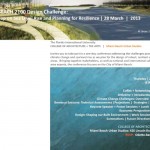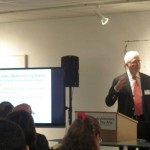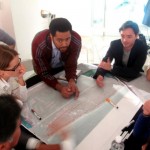The Miami Beach Design 2100: Sea Level Rise Symposium was held at the College of Architecture + The Arts Miami Beach Urban Studios on Thursday, March 28.
During a day-long conversation, experts in the field of climate change had the opportunity to share ideas about the possible responses to the challenges and opportunities posed by climate change, and how these would impact the City of Miami Beach specifically.
Among the special guests were Miami Beach Mayor Matti H. Bower, Miami Beach Commissioner Jerry Libbin, College of Architecture + Arts Dean Brian Schriner and Association of Climate Change Officers Executive Director Daniel Kreeger.
“We have to educate the public… but you can’t have them in fear. In fear mode you are going to repress the ideas” said Lawyer Albert Slap regarding breeding awareness on the topic of Sea Level Rise. Designers, scientists, policy makers, and academia discussed the many aspects that have to be considered in this situation. They identified challenges, strategies, design, technical and economic perspectives.
The keynote speaker, John Englander, presented his book “High Tide on Main Street,” and discussed how Hurricane Sandy hit the east coast just one week after releasing his book about a superstorm hitting Atlantic City and New York City.
For Wayne Pathman, Partner for Pathman, Lewis, LLC, the business community that funds constructions in the City of Miami, has to get involved in this issue. Pathman explained that it is important to close the gap between political and business leaders in order to get everyone thinking about sea level rise. “South Florida, Miami, Miami Beach is the number one city in the world today that would have the most impact from rising tide, and yet none of our political leaders or business community have really gotten behind this issue” Pathman said.
Simone Filipini, Consul General of The Netherlands in Miami, exposed the difficulties that her home country went through in 1953 after a storm flooded one fourth of the Netherlands. Filipini described that if they had not taken actions towards this reoccurring eminent issue, “we [Netherlands] would have disappeared into the ocean.” She explained how the Netherlands, also known as Lowlands, went from being mud to soild soil. Open discussions about Sea Level Rise is what helped them find solutions, as well as, combining structure and the force of nature. Filipini closed her statement by saying, “invest now or bleed heavily later.”
Using the power of design to create, innovate, and inspire solutions to societal problems is the mission the College of Architecture + The Arts at Florida International University. Therefore, in an effort to raise awareness of this pressing issue, the Department of Architecture and Landscape Architecture engage faculty and students into thinking about sea level rise in the classrooms. During the symposium, Graduate students had the opportuniy to discuss and display posters that reflected their ideas and solutions for the future of Miami Beach.
The evening closed with breakout sessions between attendees and experts discussing plans/strategies for Miami Beach going forward.
Students! Remember to follow @fiusoa on Twitter, FIUsoa on Instagram and “Like” FIU School of Architecture on Facebook for the latest news on your School of Architecture.








